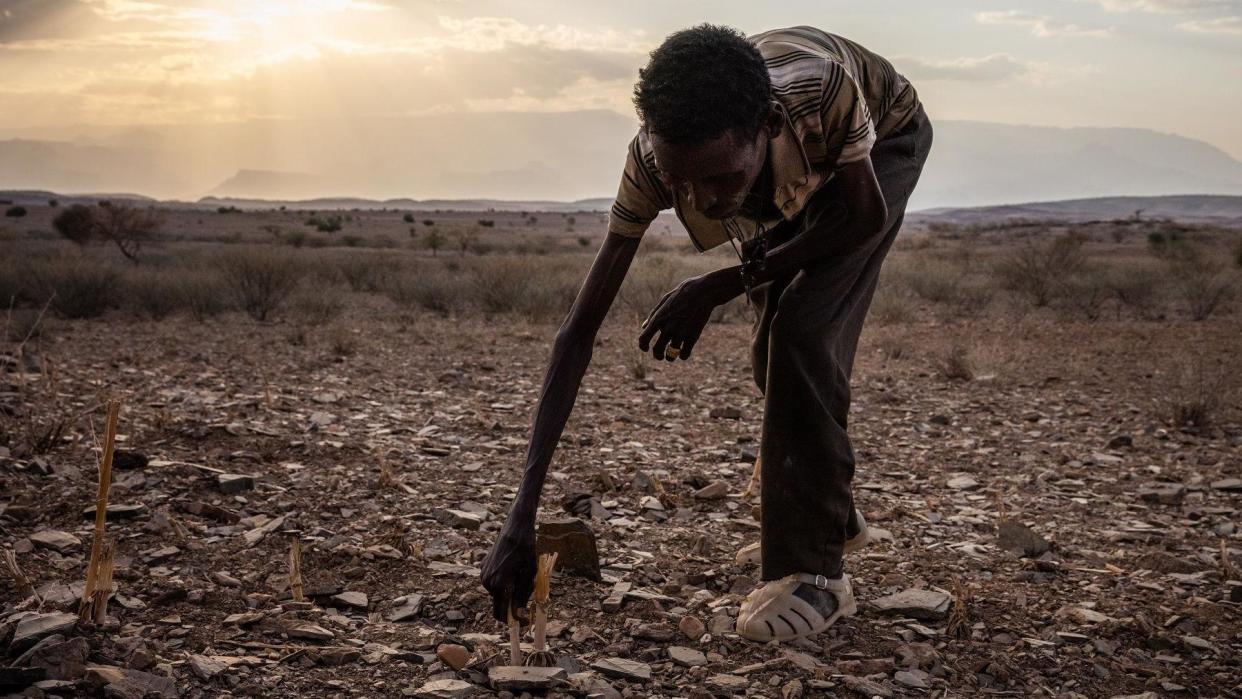UN food chief: Poorest areas have zero harvests left

Droughts and flooding have become so common in some of the poorest places on Earth that the land can no longer sustain crops, the director of the World Food Programme’s global office has said.
Martin Frick told the BBC that some of the most deprived areas had now reached a tipping point of having “zero” harvests left, as extreme weather was pushing already degraded land beyond use.
He said that as a result, parts of Africa, the Middle East and Latin America were now dependent on humanitarian aid.
Mr Frick warned that without efforts to reverse land degradation globally, richer countries would also begin to suffer crop failures.
The Global Environment Facility estimates that 95% of the world’s land could become degraded by 2050. The UN says that 40% is already degraded.
When soil degrades, the organic matter that makes it fertile disappears, EU scientists say. This means that it is less able to support plant life – reducing crop yields – and absorb carbon from the atmosphere.
Soil is the second largest carbon sink after the oceans, and is recognised by the UN as a key tool for mitigating climate change.
“There's too much carbon in the air and too little carbon in the soils,” Mr Frick said. “With every inch of soil that you're growing, you're removing enormous amounts of carbon out of the atmosphere.
“So healthy soils – carbon-rich soils – are a prerequisite to fixing climate change.”
Land degradation can be caused by modern farming techniques removing organic content from soil, but also prolonged droughts interspersed with sudden, extreme rainfall.
Scientists say many extreme weather events are becoming more frequent and intense as a result of climate change.
While it is hard to link climate change to specific droughts, scientists have said global warming has made certain ones, like the recent one in East Africa, more likely.
Mr Frick said that in Burundi, in East Africa, months of heavy rain and flooding had damaged 10% of its farmland, making it unusable for the upcoming harvest season.
He pointed to a UN report, released in March, which found that cereal crops in the Darfur region of Sudan were 78% below the average for the previous five years amid civil war and drought.
Meanwhile, flash floods in Afghanistan earlier this year are estimated to have destroyed 24,000 hectares of land already considered highly degraded.
Environmentalists expect that as soil degrades, failing crops will strain global food supplies and increase migration from affected areas.
“It's going to be disaster for human beings,” Praveena Sridhar, chief science officer of environmental group Save Soil, said. “It’s going to be like Mad Max.”
She added: “There will be no humanity. There will be no charity. There will be no fairness... The only thing that lets you be will be survival.”
Mr Frick said that, as a father of three, he was “not a fan of doomsday scenarios”, but admitted that “what we are seeing is most worrying”.
But he argued such an eventuality could be avoided by moving toward localised farming that seeks to reinvigorate the land.
The food agency chief said there was currently an “unhealthy dependence” on crops such as wheat, maize and rice, and the few nations that are large-scale exporters of them – creating food shortages that particularly affect the developing world when those nations’ harvests are interrupted.
He noted how the Russian invasion of Ukraine had caused grain shortages in places such as East Africa.
Mr Frick said that to tackle hunger and land degradation at the same time, the world’s poorest should be incentivised to rejuvenate degraded land through regenerative practices – including by being made eligible for funds from carbon credits schemes.
He cited a WFP project in Niger in which local women had created micro-dams in arid land to slow the movement of water, then used dung and straw to create a basin in which trees could be planted. The trees created shade from the sun, allowing the women to grow fruit and vegetables.
“Suddenly, within the space of three to five years, the place that was really a desert comes back as agricultural production land without artificial irrigation,” he said.
“They don't have to worry about inflation because they can substitute what they would need to buy otherwise in their own gardens. And a community garden in Bristol can do exactly the same thing.”
But Ms Sridar said the longer it takes to implement these sorts of regenerative farming techniques, the harder it will be to recover lost soil biodiversity – making humans increasingly vulnerable to shocks to the food supply.
At a UN conference in 2015, it was suggested that there were only 60 harvests left before soil becomes too degraded to support viable crops – though experts dispute hard estimates as the rate of degradation and the state of the soil differs across the world.
Mr Frick said: “How many harvests you have left is largely a function of... how we get our food production in tune with the realities of this planet.”


